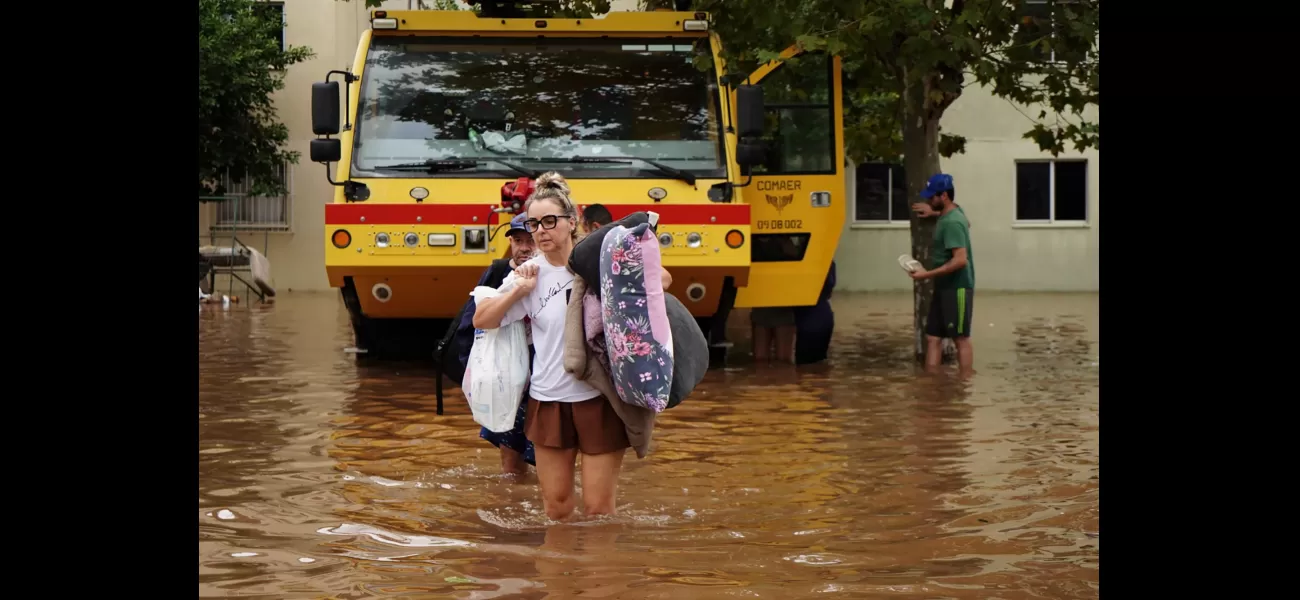At least 60 dead and 101 missing in southern Brazil due to floods.
Deadly floods in Brazil's southern state of Rio Grande do Sul claimed 60 lives and left 101 people missing, according to local officials.
May 5th 2024.

Tragedy struck Brazil's southern Rio Grande do Sul state as massive floods ravaged the region, claiming the lives of 60 people and leaving 101 others missing, according to local authorities reporting on Sunday. The devastation caused by the floods was extensive, with 155 people injured and over 80,000 forced to flee their homes. As a result, approximately 15,000 sought refuge in temporary shelters, including schools and gymnasiums.
The aftermath of the floods was a scene of destruction, with landslides, washed-out roads, and collapsed bridges scattered across the state. The situation was made even more dire as operators reported widespread cuts to electricity and communications. To add to the chaos, over 800,000 people were left without access to clean water, according to the civil defense agency, citing information from the water company Corsan.
One particularly heart-wrenching moment captured on video by local news network UOL showed residents of the town of Canoas banding together to form a human chain, wading through waist-deep muddy water to help transport those stranded to safety. The Guaiba river, which runs through the state, reached a record-high level of 17.5 feet on Sunday morning, surpassing levels seen during the historic 1941 floods.
State Governor Eduardo Leite expressed his shock at the devastation, declaring it to be unprecedented. "I repeat and insist: the devastation to which we are being subjected is unprecedented," he said on Sunday morning. He also emphasized the need for a comprehensive plan for rebuilding, comparing it to a "Marshall Plan," referencing the post-World War II reconstruction effort in Europe.
In response to the crisis, Brazilian President Luiz Inácio Lula da Silva arrived in Rio Grande do Sul on Sunday, accompanied by other government officials, including Defense Minister José Múcio, Finance Minister Fernando Haddad, and Environment Minister Marina Silva. The President's presence brought some comfort to the affected population, and even Pope Francis expressed his solidarity during Sunday mass, praying for the victims and their families.
The heavy rains, which started on Monday and were expected to continue until Sunday, were triggered by the climate phenomenon known as El Niño. This event, which naturally occurs every few years, causes warming of the surface waters in the Equatorial Pacific region and has a significant impact on weather patterns in South America. In Brazil, El Niño has historically brought droughts to the north and intense rainfall to the south.
However, this year's El Niño has been particularly severe, leading to a historic drought in the Amazon. Scientists have also linked the increase in extreme weather events to human-caused climate change, making it a pressing issue that needs to be addressed. This was the fourth environmental disaster in the state in the past year, with previous floods in July, September, and November of 2023 claiming a total of 75 lives.
Despite the devastation and loss of life, the resilience and unity of the people of Rio Grande do Sul were evident in the face of this tragedy. As the state begins to rebuild and recover, it is a reminder of the importance of preparing for and mitigating the impacts of extreme weather events in the future.
The aftermath of the floods was a scene of destruction, with landslides, washed-out roads, and collapsed bridges scattered across the state. The situation was made even more dire as operators reported widespread cuts to electricity and communications. To add to the chaos, over 800,000 people were left without access to clean water, according to the civil defense agency, citing information from the water company Corsan.
One particularly heart-wrenching moment captured on video by local news network UOL showed residents of the town of Canoas banding together to form a human chain, wading through waist-deep muddy water to help transport those stranded to safety. The Guaiba river, which runs through the state, reached a record-high level of 17.5 feet on Sunday morning, surpassing levels seen during the historic 1941 floods.
State Governor Eduardo Leite expressed his shock at the devastation, declaring it to be unprecedented. "I repeat and insist: the devastation to which we are being subjected is unprecedented," he said on Sunday morning. He also emphasized the need for a comprehensive plan for rebuilding, comparing it to a "Marshall Plan," referencing the post-World War II reconstruction effort in Europe.
In response to the crisis, Brazilian President Luiz Inácio Lula da Silva arrived in Rio Grande do Sul on Sunday, accompanied by other government officials, including Defense Minister José Múcio, Finance Minister Fernando Haddad, and Environment Minister Marina Silva. The President's presence brought some comfort to the affected population, and even Pope Francis expressed his solidarity during Sunday mass, praying for the victims and their families.
The heavy rains, which started on Monday and were expected to continue until Sunday, were triggered by the climate phenomenon known as El Niño. This event, which naturally occurs every few years, causes warming of the surface waters in the Equatorial Pacific region and has a significant impact on weather patterns in South America. In Brazil, El Niño has historically brought droughts to the north and intense rainfall to the south.
However, this year's El Niño has been particularly severe, leading to a historic drought in the Amazon. Scientists have also linked the increase in extreme weather events to human-caused climate change, making it a pressing issue that needs to be addressed. This was the fourth environmental disaster in the state in the past year, with previous floods in July, September, and November of 2023 claiming a total of 75 lives.
Despite the devastation and loss of life, the resilience and unity of the people of Rio Grande do Sul were evident in the face of this tragedy. As the state begins to rebuild and recover, it is a reminder of the importance of preparing for and mitigating the impacts of extreme weather events in the future.
[This article has been trending online recently and has been generated with AI. Your feed is customized.]
[Generative AI is experimental.]
0
0
Submit Comment





